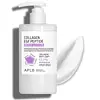What's inside
What's inside
 Key Ingredients
Key Ingredients

 Benefits
Benefits

 Concerns
Concerns

 Ingredients Side-by-side
Ingredients Side-by-side

Water
Skin ConditioningUrea
BufferingGlycerin
HumectantIsopropyl Stearate
EmollientDicaprylyl Ether
EmollientGlyceryl Glucoside
HumectantSodium Lactate
BufferingButyrospermum Parkii Butter
Skin ConditioningPolyglyceryl-4 Diisostearate/Polyhydroxystearate/Sebacate
EmulsifyingTapioca Starch
Carnitine
CleansingCetearyl Alcohol
EmollientCeramide NP
Skin ConditioningArginine Hcl
Skin ConditioningSodium PCA
HumectantHistidine Hcl
Skin ConditioningLactic Acid
BufferingMannitol
HumectantArginine
MaskingSerine
MaskingSucrose
HumectantPCA
HumectantCitrulline
Skin ConditioningGlycogen
HumectantAlanine
MaskingThreonine
Glutamic Acid
HumectantLysine Hcl
Skin ConditioningSodium Chloride
Masking1,2-Hexanediol
Skin ConditioningPhenoxyethanol
PreservativePotassium Sorbate
PreservativeWater, Urea, Glycerin, Isopropyl Stearate, Dicaprylyl Ether, Glyceryl Glucoside, Sodium Lactate, Butyrospermum Parkii Butter, Polyglyceryl-4 Diisostearate/Polyhydroxystearate/Sebacate, Tapioca Starch, Carnitine, Cetearyl Alcohol, Ceramide NP, Arginine Hcl, Sodium PCA, Histidine Hcl, Lactic Acid, Mannitol, Arginine, Serine, Sucrose, PCA, Citrulline, Glycogen, Alanine, Threonine, Glutamic Acid, Lysine Hcl, Sodium Chloride, 1,2-Hexanediol, Phenoxyethanol, Potassium Sorbate
Water
Skin ConditioningCentella Asiatica Leaf Water
Skin ConditioningGlycerin
HumectantCetyl Ethylhexanoate
EmollientCetearyl Alcohol
EmollientGlyceryl Stearate
EmollientPEG-100 Stearate
Sorbitan Stearate
Emulsifying1,2-Hexanediol
Skin ConditioningCyclopentasiloxane
EmollientSaccharide Hydrolysate
HumectantDimethicone
EmollientCyclohexasiloxane
EmollientStearic Acid
CleansingChlorphenesin
AntimicrobialCarbomer
Emulsion StabilisingGlyceryl Stearate Se
EmulsifyingCaprylyl Glycol
EmollientXanthan Gum
EmulsifyingPotassium Hydroxide
BufferingDisodium EDTA
Hydrolyzed Collagen
EmollientButylene Glycol
HumectantDipropylene Glycol
HumectantSqualane
EmollientAsiaticoside
AntioxidantMadecassic Acid
Skin ConditioningAsiatic Acid
Skin ConditioningSodium Hyaluronate
HumectantMelaleuca Alternifolia Leaf Extract
PerfumingHippophae Rhamnoides Fruit Extract
Skin ConditioningEthylhexylglycerin
Skin ConditioningBeta-Glucan
Skin ConditioningNelumbium Speciosum Flower Extract
Skin ConditioningArtemisia Annua Extract
MaskingOryza Sativa Extract
AbsorbentSaccharomyces Ferment
Skin ConditioningSolanum Melongena Fruit Extract
Skin ConditioningSh-Oligopeptide-1
Skin ConditioningWater, Centella Asiatica Leaf Water, Glycerin, Cetyl Ethylhexanoate, Cetearyl Alcohol, Glyceryl Stearate, PEG-100 Stearate, Sorbitan Stearate, 1,2-Hexanediol, Cyclopentasiloxane, Saccharide Hydrolysate, Dimethicone, Cyclohexasiloxane, Stearic Acid, Chlorphenesin, Carbomer, Glyceryl Stearate Se, Caprylyl Glycol, Xanthan Gum, Potassium Hydroxide, Disodium EDTA, Hydrolyzed Collagen, Butylene Glycol, Dipropylene Glycol, Squalane, Asiaticoside, Madecassic Acid, Asiatic Acid, Sodium Hyaluronate, Melaleuca Alternifolia Leaf Extract, Hippophae Rhamnoides Fruit Extract, Ethylhexylglycerin, Beta-Glucan, Nelumbium Speciosum Flower Extract, Artemisia Annua Extract, Oryza Sativa Extract, Saccharomyces Ferment, Solanum Melongena Fruit Extract, Sh-Oligopeptide-1
 Reviews
Reviews

Ingredients Explained
These ingredients are found in both products.
Ingredients higher up in an ingredient list are typically present in a larger amount.
1,2-Hexanediol is a synthetic liquid and another multi-functional powerhouse.
It is a:
- Humectant, drawing moisture into the skin
- Emollient, helping to soften skin
- Solvent, dispersing and stabilizing formulas
- Preservative booster, enhancing the antimicrobial activity of other preservatives
Cetearyl alcohol is a mixture of two fatty alcohols: cetyl alcohol and stearyl alcohol. It is mainly used as an emulsifier. Emulsifiers help prevent the separation of oils and products. Due to its composition, it can also be used to thicken a product or help create foam.
Cetearyl alcohol is an emollient. Emollients help soothe and hydrate the skin by trapping moisture.
Studies show Cetearyl alcohol is non-toxic and non-irritating. The FDA allows products labeled "alcohol-free" to have fatty alcohols.
This ingredient is usually derived from plant oils such as palm, vegetable, or coconut oils. There is debate on whether this ingredient will cause acne.
Due to the fatty acid base, this ingredient may not be Malassezia folliculitis safe.
Learn more about Cetearyl AlcoholGlycerin is already naturally found in your skin. It helps moisturize and protect your skin.
A study from 2016 found glycerin to be more effective as a humectant than AHAs and hyaluronic acid.
As a humectant, it helps the skin stay hydrated by pulling moisture to your skin. The low molecular weight of glycerin allows it to pull moisture into the deeper layers of your skin.
Hydrated skin improves your skin barrier; Your skin barrier helps protect against irritants and bacteria.
Glycerin has also been found to have antimicrobial and antiviral properties. Due to these properties, glycerin is often used in wound and burn treatments.
In cosmetics, glycerin is usually derived from plants such as soybean or palm. However, it can also be sourced from animals, such as tallow or animal fat.
This ingredient is organic, colorless, odorless, and non-toxic.
Glycerin is the name for this ingredient in American English. British English uses Glycerol/Glycerine.
Learn more about GlycerinWater. It's the most common cosmetic ingredient of all. You'll usually see it at the top of ingredient lists, meaning that it makes up the largest part of the product.
So why is it so popular? Water most often acts as a solvent - this means that it helps dissolve other ingredients into the formulation.
You'll also recognize water as that liquid we all need to stay alive. If you see this, drink a glass of water. Stay hydrated!
Learn more about Water